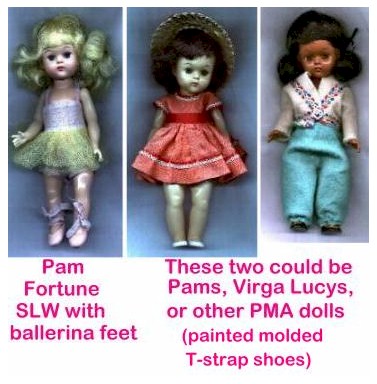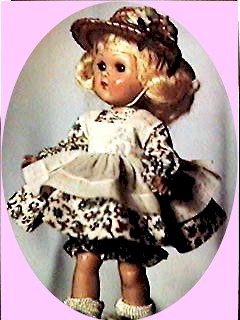
PRESENTED BY LITTLEDOLL
In 1890, in
Somerville Mass. Jennie Adler,
the founder of Vogue Dolls, was born. Her
family can be traced back to the Mayflower.
Her mother was the sister of Alfred C.
Fuller, founder of the Fuller Brush Co. Fifty
years after Jennie's birth, Alfred was
destined to play a role in the Vogue Doll
story.
Jennie demonstrated a love for sewing in her
early childhood. Using scraps of material
discarded by the family seamstress, she would
fashion outfits for her doll collection. This
shaped her future destiny.
Jennie is far left in this picture from the Ginny Doll Encyclopedia.
By the second decade of the 20th century, Jennie had married and became Mrs. Jennie Graves. She had three children and she was kept busy designing and sewing outfits for her two daughters and son. The eldest of which was named Virginia.
Her reputation as a designer of clothes spread through out the community. Although busy with the demands on her skills, Jennie still found time to dress some dolls that were offered to a local church bazaars. As much as Jennie enjoyed making thise contributions to good causes, she was shocked to discover that some of her dressed dolls had ended up in a large retail store in Boston with hefty price tags.
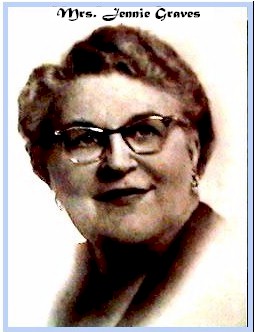
Jennie had developed very clear opinions about dolls, such as; dolls should be designed as companions for children to play with; dolls should be readily available to all children to help in the development of their charcter and to stretch their imaginations.
At first Jennie bought large German bisque dolls by K&R. She also bought 10" AM Just Me dolls and 8" Peggy Jean. She dressed them in her home in West Somerville, Mass. They can still be found dressed in original clothes with the Vogue label. VOGUE DOLLS HAD IT'S BEGINNING!
At first the company was known as "Ye Olde Vogue Doll Shoppe" then, "The Vogue Doll Shoppe" and finally, "Vogue Dolls Inc." Jennie pinned orders for doll clothes to a curtain behind her sewing machine. After she finished the order she threw the paper away! She cut her patterns out of old newspapers and put them in a manila envelope with instructions and amount of material needed on the outside.
Now a surprise!! Our own Leanne's Great Grandmother used to make clothes in her home as part of the Cottage Industry when Vogue was using home sewers. She did them on a treadle machine! At a Meyer' Ginny Circus Luncheon, Arlene (the owner) had Leanne's Mother stand and tell the story!
After several moves, the Vogue Co. settled in Medford. During the 30's, business prospered and there were some 50 people on the payroll, mostly women friends.
In 1939, with the threat of war and her husband's death, Jennie's uncle, Alfred C. Fuller, underwrote her first note at the bank after convincing Jennie to start her own business. By 1951, there were 2 plants in operation. One in Medford and one in Malden.
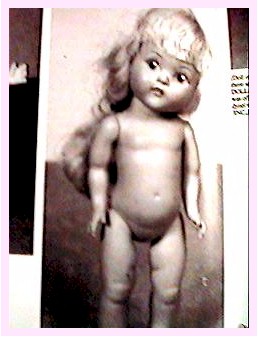
In the beginning the 8" straight leg doll was given different names, depending on which outfit she wore. Some of the names were Cathy, Alice, Wanda and Pamela.
In 1950 outfit #83R was called Ginny, but no real signifigance is given to that fact.
It was not until 1951 that Mrs. Graves made the decision to call her creation "Ginny" in honor of her daughter Virginia.
At the NY Toy Fair, that same year, Ginny was officially named.

The first 8" Ginny, made two years only, was designed by Bernard Lipfert, the famous designer of Shirley Temple, Pastsy, Howdy Doody, The Dionne Quints and Betsy McCall.
She had painted eyes, blond or brown mohair wig over molded hair. She was a straight leg non-walker marked Vogue Doll on the back of the head and some were marked Vogue Doll on the back of the body.
Crib Crowd Babies were introduced. They are also hard plastic, had painted eyes, molded hair with ringlet wigs. They had bent baby legs. They wore rubber pants and baby style dresses made of dotted swiss, flocked organdy and cotton dimity.
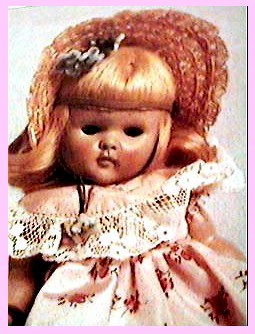
 From 1950-53 sleep eyes
with
painted
lashes were added.
From 1950-53 sleep eyes
with
painted
lashes were added.
They were straght leg with dynel wigs.
Marked Vogue on the back of the head and Vogue doll on the back.
The straight leg poodle cut was offered one year only in 1952, with the same marks.
(Photo not available.)
In 1954 there was a straight leg walker marked:
Ginny/Vogue Dolls Inc/Pat.Pend./Made in USA.

In 1955 Ginny had plastic molded lashes added to her sleep eyes.
She was a straight leg walker with dynel or saran wig.
Marked:
Ginny/Vogue Doll Inc. Pat.No. 2687594/Made in USA.
In 1957 Ginny became a bent knee walker.
She also has molded lashes.
She is marked:
The same as the 1955 straight leg walker.
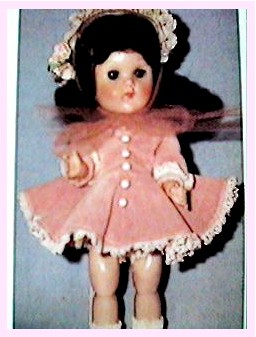
Ginny's Growing Up Years
1954 was the beginning of the walking mechanism, the birth of the Wizz Kids Group, catching of Freddie the fish, production of a new tu-tu for the Ballerina and Davy Crockett with his Frontier Scout button, long rifle and real fur cap. The dolls of this year were marked with the patent # 26877594.
The most important event of this busy year was that Jennie Graves became Mrs. Stanley Carlson. The molded lash addition gave Ginny the appearence of a little girl 7 or 8 years instead of the 3 or 4 year old toddler of the years preceeding.
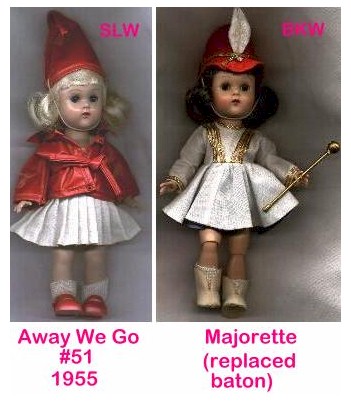
1957 was the year of magic and make believe. There were gala events all over the Country where Ginny was the guest of honor. A few examples are, fashion shows, Charity fund raisers and even birthday parties for daughters of celebrities. Ginny was also the star of a short movie entitled " The Dolls in Your Life"!
Many factors led to the problems that Vogue experienced in the 60s, not the least of which was Barbie! Barbie was what all pre-teens wanted to be, and the fact that Barbie was advertized on TV didn't help. Mrs. Graves did not believe in advertizing on TV!
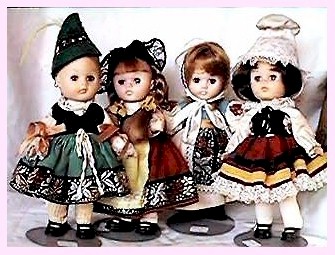
All vinyl Ginnys were introduced in 1965. The 1984 dolls were molded in their likeness. The last year for American made Ginny was 1969. In 1973 Tonka bought Vogue and the Ginny name. Lesney Products bought Vogue in 1977. Ginny lost her popularity during these years.
In 1983 Meritus Industries bought Vogue. With the winning combination of Wally Reiling, President of Meritus, and Sue Nettleingham, consultant and product designer, Ginny became popular again!
There are so many Ginny fashions, that they would take forever to list! I suggest that anyone interested in Ginny buy "The Ginny Doll Encyclopedia" by Sue Nettleingham Roberts and Dorothy Bunker.
